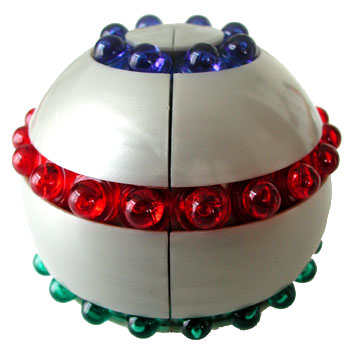|
A bead-moving puzzle that came in at least four different versions. The non-english versions have their own entry.
Each pole ring has 8 beads, and each equatorial ring has 20 beads. Some versions vary on which colours go where. The unique feature of this puzzle is that it starts with four loops but is not restricted to that configuration. One turn of 45° (see image 2) creates a single continuous stream of beads around the puzzle. One turn of 90° creates two oval loops of beads arranged like the seams on a baseball or tennis ball. The puzzle isn't too difficult, only requiring a few simple tricks to solve. The Orb is a fun puzzle to manipulate. It turns smoothly, has a massage-like effect, and makes a lot more noise than we twisty fans are used to! It has US patent US4553754 (Filed 16 Feb 1982, granted 19 Nov 1985) and British patent GB8113543 (1 May 1981). Images 15-20 show an english package of taiwanese origin. It resembles the japanese version from Tomy, produced in Hong Kong. Diameter: 85 mm Contributors
Thank you to the following people for their assistance in helping collect the information on this page: Sandy, Anthony Au. Collections This puzzle can be found in collections of these members: Sandy: My Collection Michael: My Collection Joshua Bell: My Collection Carter: My Collection Jin H Kim: My Collection Frank: My Collection katsmom: Puzzle Palace Twisty's Bruno: My Collection Ed Cambridge: My Collection riddler17: My Collection Dan: My Collection John Redvers Rooney: My Collection jaap: Jaap's Collection Vadim: My Collection Oscar: My Collection Jeff Goetz: My Collection Tim L: My Collection dbannon: My Collection isacisco: My Collection Liz Burrow: My Collection Markus: My Collection Adam Zamora: My Collection Roman: Roman's Twisty Collection Juozas Granskas: My Collection PuzzleManiac: My Collection fiveolddogs: My Collection fiveolddogs: My Collection fiveolddogs: My Collection fiveolddogs: My Collection Andreas Nortmann: Andreas' collection Jorge: Jorge's Cubes Collection Georges: Part of Georges' Collection philipk: My Collection Darren Grewe: My Collection darryl: My Collection m0monga183: My Collection skeneegee: My Collection nmpuzzler: My Collection DaleKH: My Collection away: My Collection DavidF: My Collection dougr33d: My Collection sausage: My Collection Darren Grewe: My Collection _pink: My Collection Trevor Sayre: My Collection Aleksey: My Collection nicky_uk: My Collection Hidetoshi: My Collection Ben Hendry: My Collection micro500: My Collection mamessing: My Collection localhost: My Collection Bryan: My Collection howru2day: My Collection Victoria: My Collection Swedishlf: My Collection Jenilia: My Collection merlintocs: My Collection kastellorizo: My Collection Gus: My Collection wolfy: My Collection mgwallisa: My Collection S.Rubiks: My Collection irish: My Collection Scott Bedard: My Collection Stanislav TVRDIK: My Collection rubik_fr: My Collection Frank Tiex: Frank's Collection Q: Q's "cubes" DLitwin: My Collection Twisty_Jones: My Collection pdrenski: My Collection kastellorizo: My Collection Noah: My Collection Esper48: My Collection JasonSmith: My Collection gee3092004: My Collection a passion for puzzles: My Collection nate2007: My Collection geduldspiele: My Collection HBMAN: HBM@N's Puzzles cliftar: mod-nificant TheAtarian1: My Collection Marcus Luna: My Collection gabrielmpf: Gabriel's Puzzle Collection 512456: My collection Laurence: Parlour Puzzles Geo: part of collection Rob: Rob's Collection Jak: My Collection ptrsdboy: My Collection rubik-maze: rubik-maze.de collection Scarlett: My Collection th30d: My collection Mark Havens: Mark's General Collection billdrumz: My Collection misterpoopoohead: MisterPooPooHead's Collection. Zzupler: Zzupler's puZzlers LinerPZ: Emil's Collection lunny: Lunny's Collection Cubrick: Cubrick's collection Chino: Chino's Collection 130jack: Common Puzzles mixer: My collection husotaso: Huso's Collection MainMovieMan: MainMovieMan Philipp13: The biggest collection of puzzles in Russia 130jack: Uncommon Puzzles clauswe: Claus' Twisty Puzzle Collection Puzzlemad: Puzzlemad's twisty collection Master_Twister: My Collection sergI: My Collection solucions: MI COLECCION demongod: Getting large chewbacca: Chewbacca's Collection hnucuber: ZJY's collection CK_cheong: KaCheong's Collection kbloise318: Bloise's Twisty Puzzle Collection harleythedragon: HarleyTheDragon's Puzzles Stevo7771: Started Collecting Around August 2016 Beeswaxin: Beeswaxin's collection Cube_addict: Cube_addict's Collection TylerMcDaniels: Tyler's Collection TylerMcDaniels: Tyler's Collection Githzerai: My Collection kastellorizo: My Collection gramotej: My growing collection Shell Snair: Shell's Collection (Maintenance in Progress) grigr: Grigorusha Collection fbgrac: Bini's Collection Pluton: Twistypuzzles dcden: From 1980 to today katsmom: Puzzle Palace Twisty's katsmom: Puzzle Palace Twisty's Trung Dung: Trung Dung small collection Markube: Mark's Kubes PuzzleAF: I Swear I'm Not a Hoarder SGCuber: Sean's Collection ironesp: Miguel's Collection John7152: Have I Got Cubes For You riversible: Riversible's puzzle collection GaS: GaS's TwistyPuzzles Victor Farles: Farles collection Found a mistake or something missing? Edit it yourself or contact the moderator. |
|




















